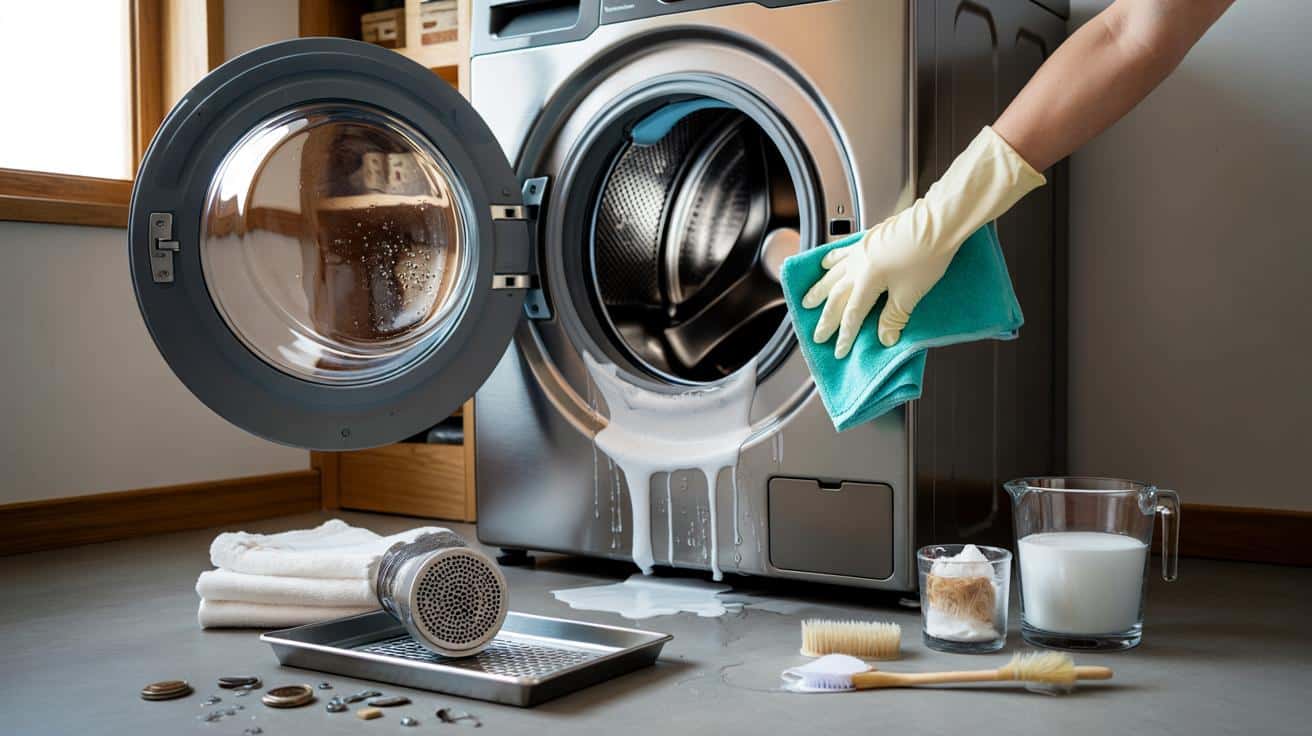The silent culprit behind sour, damp-smelling laundry isn’t your detergent or your socks — it’s a tired, grimy drum holding on to residues and bacteria. We’ve all had that moment when a “fresh” load smells like a wet tent. Here’s how to stop the stink for good.
There’s that sour, damp note that clings to towels and lurks in T‑shirts, a smell that laughs at fragrance beads and spring meadow pods. I watch the drum spin down and see the truth in the rubber folds: a dark seam of lint, oily specks on metal, a drawer crusted with old softener like candle wax.
I pull one grey hoodie to my face and it smells like a rainy bin bag. On the windowsill, a line of rescued pegs, a cracked mug of stray coins, a to-do list that says “clean machine?” from months ago. A kettle whistles; it feels like a sign. I fill it, then stop, because this needs a plan, not panic.
The fix is hiding in plain sight.
Why your drum smells — and what it’s hiding
Most odours begin with a biofilm: a clingy blend of leftover detergent, fabric softener, body oils and lint that sticks to the drum, the door seal and the hidden pipework. Low-temp quick washes don’t dissolve it. Eco cycles save energy, great, yet they rarely blast the gunk that loves warm, damp, dark places.
Picture a four-year-old machine in a flatshare: cold cycles, heavy softener, and back-to-back loads. The clothes smell “clean” out of the drum, then turn musty by evening. One hot maintenance wash, a scrub of the seal, and a clean filter later, the odour drops off a cliff. Nothing magic. Just physics, heat, and a bit of elbow grease.
Detergent is a surfactant; it grabs dirt and suspends it in water. Too little and grime clings on. Too much and it leaves a sticky film the rinse can’t clear. Microfibres shed from clothes and settle in the seal’s folds, trapping moisture. The drain filter collects everything else. **Overdosing detergent makes odours worse, not better.**
Deep-clean routine: a one-hour reset that actually works
Start with an empty drum. Pull out the detergent drawer and soak it in hot, soapy water; scrub the channels with an old toothbrush. Wipe the door seal inside and out with warm washing-up liquid, pulling back the folds to lift lint and slime. Run a hot “Drum Clean” or 60–90°C cycle with either a machine cleaner or 250 ml white vinegar in the drum. Then run a short rinse with 2–3 tablespoons of bicarbonate of soda to neutralise remaining odours. **Never mix bleach with vinegar or acids.** If mould is stubborn, run a separate hot cycle with a small dose of oxygen bleach, then a plain rinse.
Now the filter: pop off the kick panel, set a tray and towel under the drain, and twist the cap slowly. Let the water out, remove coins, hair, and grit, and rinse the filter under the tap. Refit, wipe the drum with a microfibre cloth, and leave the door and drawer ajar to dry. Let’s be honest: nobody actually does this every day.
This routine works because heat melts fats, surfactants lose their grip, and airflow denies mould its favourite climate.
“Nine times out of ten, a hot cycle, a clean filter, and the drawer scrub sort it,” says Tom, an appliance engineer from Leeds. “People think the machine is broken when it’s really just grubby.”
- Use the right dose for your water hardness and load size.
- Powder for whites, liquid for colours; go easy on softener.
- Leave the door and drawer open between washes.
- Run a hot maintenance cycle monthly.
- Bleach only in an empty machine, never with acids, and rinse well.
Keep-it-clean habits that don’t feel like chores
Think of it as tiny rituals that stack. Wipe the seal while the kettle boils. Flick the drawer out every couple of weeks and give it a two-minute scrub. Do one hot wash a month — towels or a dedicated maintenance cycle — to melt the film before it wins. **A clean machine makes clean clothes.**
Hard water leaves limescale that shelters grime, so consider a citric-acid cycle now and then if you live in a chalky area. Go light on softener; it’s the gluey culprit in many horror drums. If the room’s damp, add a bit of airflow or crack a window after washes. You can smell the difference in a day.
Once the drum smells neutral, your detergents actually sing. Whites stop going grey. Gym kit dries without that wet-dog throb. You might find yourself peering at the glass mid-cycle like it’s a tiny aquarium. That’s not odd. It’s a small domestic victory you can repeat, month after month.
The signs to watch — and what to do next
There’s a rhythm to a healthy machine. Clothes come out smelling like nothing, which is perfect; scent should come from your detergent, not the drum. If a sour note creeps back, it’s your nudge: run a hot cycle, clean the filter, crack the door, and reset. Share the routine with housemates. Stick a note on the inside of the door. Small habits, big payoff.
| Key points | Detail | Reader Interest |
|---|---|---|
| Cause of odour | Biofilm from detergent, softener, oils and lint in the drum, seal and pipes | Explains why “clean” laundry can still smell |
| One-hour reset | Drawer soak, seal wipe, hot empty cycle, bicarbonate rinse, filter clean, air-dry | Actionable routine you can copy today |
| Habits that stick | Right dosing, monthly hot wash, door ajar, light on softener, tackle limescale | Prevents the stink from returning |
FAQ :
- How often should I clean the washing machine drum?Do a quick wipe weekly, and a hot maintenance cycle plus filter clean once a month. In busy homes or hard-water areas, bump the hot cycle to every two weeks.
- Is vinegar safe for my machine?In moderate amounts, yes for stainless drums and most seals — run it in an empty hot cycle and follow with a rinse. Check your manual if your brand warns against acids.
- Can I use bleach to kill mould?Yes, in an empty drum, diluted, and never alongside vinegar or citric acid. Run a plain rinse afterwards, and avoid splashing undiluted bleach on rubber parts.
- What temperature should a maintenance wash be?60°C works for most build-up; 90°C tackles heavy grime and limescale. If your machine has a “Drum Clean” programme, use that.
- My clothes still smell after cleaning — what else could it be?Check the drain hose height, the standpipe trap, and the room’s ventilation. Overloading, old softener-heavy towels, and a clogged filter are common culprits too.








